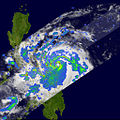Ficheiro:TY Xangsane 20060926 TRMM.jpg
Aspeto

Dimensões desta antevisão: 600 × 600 píxeis. Outras resoluções: 240 × 240 píxeis | 480 × 480 píxeis | 768 × 768 píxeis | 1 024 × 1 024 píxeis.
Imagem numa resolução maior (1 024 × 1 024 píxeis, tamanho: 606 kB, tipo MIME: image/jpeg)
Histórico do ficheiro
Clique uma data e hora para ver o ficheiro tal como ele se encontrava nessa altura.
| Data e hora | Miniatura | Dimensões | Utilizador | Comentário | |
|---|---|---|---|---|---|
| atual | 05h37min de 8 de outubro de 2006 |  | 1 024 × 1 024 (606 kB) | Coredesat | {{Information |Description=NASA TRMM satellite image showing the well-defined eye of Typhoon Xangsane prior to its first landfall on Samar Island on September 26, 2006. |Source=[http://earthobservatory.nasa.gov/NaturalHazards/natural_hazards_v2.php3?img_i |
Utilização local do ficheiro
A seguinte página usa este ficheiro:
Utilização global do ficheiro
As seguintes wikis usam este ficheiro:
- en.wikipedia.org


